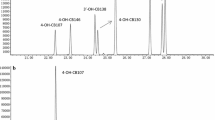Abstract
Levels of benzo(a)pyrene-diolepoxide (BaPDE)-albumin and BaPDE-hemoglobin adducts in wild woodchucks (Marmota monax) have been measured to evaluate the potential usefulness of these parameters in the assessment of environmental contamination by polycyclic aromatic hydrocarbons (PAHs). Blood was obtained from nine woodchucks living near an aluminum electrolysis plant, contaminated area (Saguenay region, Québec, Canada), and from eight living in a control area (Saint-Roch-des-Aulnaies, Québec, Canada). Blood samples were collected and plasma separated from red blood cells by centrifugation on site. Isolation of albumin (Alb) and hemoglobin (Hb) was performed in our laboratory and each protein fraction was subjected to mild acid hydrolysis yielding free benzo(a)pyrene (BaP) tetrol from the adducts. The analysis was performed by high performance liquid chromatography (HPLC) using fluorescence detection. For the control and contaminated areas geometric mean (interval) Alb adduct levels were 7.6 (0.8–29.3) and 69.6 (10.0–1,103) pmol tetrol/g protein (p<0.01) while the corresponding figures for Hb adduct levels were 0.40 (0.01–2.72) and 1.18 (0.02–12.8) pmol/g protein (p>0.01). Alb but not Hb adduct levels were associated with the measured concentration of BaP in the vegetation samples collected on the site where each animal was found. This is compatible with the short half-life of Alb adducts and with the instantaneous image provided by BaP measurements in the collected vegetation samples. BaPDE-blood protein adducts measured in wild animals appear to be good biomarkers of environmental contamination by PAHs.
Similar content being viewed by others
References
Batty J, Leavitt RA, Biondo N, Polin D (1990) An ecotoxicological study of a population of the white footed mouse (Peromyscus leucopus) inhabiting a polychlorinated biphenyls-contaminated area. Arch Environ Contam Toxicol 19:283–290
Blum SC, Swarbrick RE (1977) Hydroponic growth of crops in solutions saturated with [14C] benzo(a)pyrene. J Agric Food Chem 25:1093–1096
Coates J, Elzerman AW, Garrison AW (1985) PAH uptake by plants: Methodology and initial investigations. U.S. Environmental Protection Agency No EPA/600/D-85/036, Athens, GA
De Flora S, Camoirano A, Romano M, Astengo M, Cesarone CF, Millman I (1987) Metabolism of mutagens and carcinogens in woodchuck liver and its relationship with hepatitis virus infection. Cancer Res 47:4052–4058
Edwards NT (1983) Polycyclic aromatic hydrocarbons (PAH's) in the terrestrial environment—A review. J Environ Qual 12:427–441
Environment Canada (1988) Inventaire des sources d'hydrocarbures aromatiques polycycliques au Québec, Conservation et protection, No 55526, Lavalin Environnement
Hemminki K, Savolainen H (1980) Alkylation of rat serum proteins by dimethylnitrosamine and acetyl aminofluorene. Toxicol Lett 6:433–437
Henderson RF, Bechtold WE, Bond JA, Sun JD (1989) The use of biological markers in toxicology. CRC Crit Rev Toxicol 20:65–82
IARC (1973) IARC monographs on the evaluation of carcinogenic risk of chemicals to man, vol. 3, Certain polycyclic aromatic hydrocarbons and heterocyclic compounds. IARC, Lyon
Kirkland C, Brace MD (1953) Life span of the marmot erythrocyte. Blood 8:648–650
Miller EC (1978) Some current perspectives on chemical carcinogenesis in humans and experimental animals. Cancer Res 38:1479–1496
Osterman-Golkar S, Ehrenberg L, Segerbäck D, Hallström (1976) Evaluation of genetic risks of alkylating agents. II. Haemoglobin as a dose monitor. Mutat Res 34:1–10
Peirera MA, Chang LW (1981) Binding of chemical carcinogens and mutagens to rat hemoglobin. Chem Biol Interact 33:301–305
Sawicki E (1964) The separation and analysis of polynuclear aromatic hydrocarbons present in the human environment. Chem Anal 43:24–26, 28–30, 56–62, 88–91
Shugart L (1985) Quantitating exposure to chemical carcinogens: in vivo alkylation of hemoglobin by benzo(a)pyrene. Toxicology 34:211–220
Shugart LR, Adams SM, Jiminez BD, Talmage SS, McCarthy JF (1989) Biological markers to study exposure in animals and bioavailability of environmental contaminants. In: Wang RG, Franklin CA, Honeycutt RC, Reinert JC (eds) Biological monitoring for pesticide exposure. Measurement, estimation, and risk reduction. American Chemical Society, Washington DC, p 387
Sims P, Grover PL, Swaisland A, Pal K, Hewer A (1974) Metabolic activation of benzo(a)pyrene proceeds by a diol-epoxide. Nature Lond 252:326–327
Skipper PL, Obiedzinski MW, Tannenbaum SR, Miller DW, Mitchum RK, Kadlubar FF (1985) Identification of the major serum albumin adduct formed by 4-aminobiphenyl in vivo in rats. Cancer Res 45:5122–5127
Thériault G, De Guire L, Cordier S (1981) Reducing aluminum: An occupation possibly associated with bladder cancer. Can Med Assoc J 124:419–425
Travis CC, Hattemer-Frey HA (1988) Uptake of organics by aerial plant parts: A call for research. Chemosphere 17:277–283
Young RA, Rajatanavin R, Braverman LE, Tennant BC (1986) Seasonal changes in serum thyroid hormone binding proteins in the woodchuck (Marmota monax). Endocrinol 119:967–971
Zedeck MS (1980) Polycyclic aromatic hydrocarbons: A review. J Environ Pathol Toxicol 3:537–567
Author information
Authors and Affiliations
Rights and permissions
About this article
Cite this article
Blondin, O., Viau, C. Benzo(a)pyrene-blood protein adducts in wild woodchucks used as biological sentinels of environmental polycyclic aromatic hydrocarbons contamination. Arch. Environ. Contam. Toxicol. 23, 310–315 (1992). https://doi.org/10.1007/BF00216239
Received:
Revised:
Issue Date:
DOI: https://doi.org/10.1007/BF00216239




